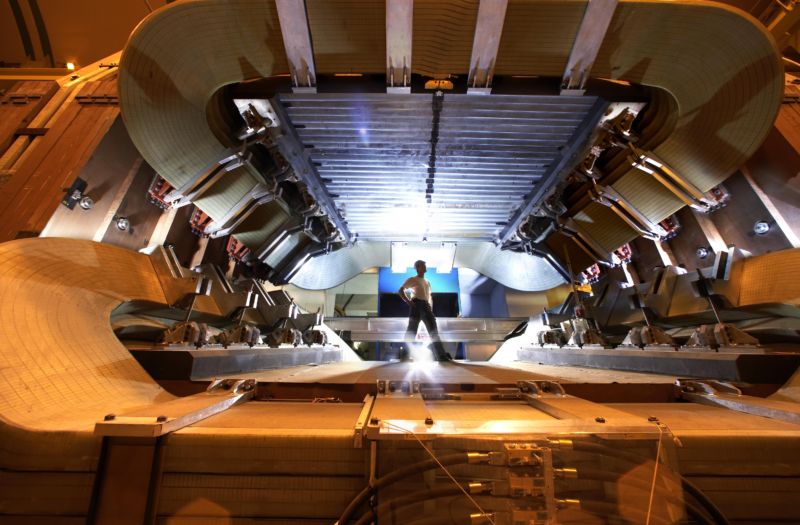
The Large Hadron Collider has generated a staggering amount of data in its years of operation; it's enough data that we'll be analyzing it for years after the collider shuts down. In the meantime, priority has gone to searches for big-ticket items like the Higgs boson (tick) and dark matter particles (MIA). But with time, some other analyses have managed to get done, and they're beginning to turn up unexpected results.
Quark-gluon plasma
In the current Universe, quarks are held together by gluons to form particles like protons and neutrons. In the first fractions of a second after the Big Bang, however, the Universe was too hot and dense for this to work. Instead, there was a thick soup of quarks and gluons that freely intermingled rather than settling down to form particles.
This quark-gluon plasma was first detected in Brookhaven's Relativistic Heavy Ion Collider, and the LHC was designed to study it at higher energies. To do that, time is allocated each year for collisions involving lead atoms, which contain lots of protons and neutrons and thus provide the quark-gluon plasma with lots of starting material. But a new paper in Nature Physics indicates that it might not be absolutely necessary to smash heavy atoms together to create the quark-gluon plasma; the protons used in normal collisions will do.
The tell-tale sign that this is happening is the presence of an excess of strange quarks, a heavier, unstable relative of the up and down quarks found in normal matter. Strange quarks are often produced in proton-proton collisions, but they are produced in larger numbers when a quark-gluon plasma is present. We've seen that both at Brookhaven and in the LHC during lead ion collisions.
But the new paper indicates that the same thing happens in proton-proton collisions. There's a bias toward the production of strange quarks that is independent of the energy collision, but this correlates with the number of particles produced during the collision. This is the same behavior we see in lead collisions, as well.
(The authors refer to the production of strange quarks as "strangeness," leading to some odd sentences like, "Strangeness is produced in hard (perturbative) 2 → 2 partonic scattering processes by flavour creation and flavour excitation. Strangeness is also created during the subsequent partonic evolution via gluon splittings.")
The authors conclude that we're probably forming a tiny bit of quark-gluon plasma during proton-proton collisions at the LHC. And the similarity between the results produced there and those produced by colliding heavier particles suggests there's a single physical mechanism underlying quark-gluon plasma formation. So further study of this process with protons may help us better understand this mechanism and thus the behavior of the Universe in its earliest moments.
Care for some muons with that?
The quark-gluon plasma produced by collisions vanishes almost instantly, as its constituents quickly find partners and form stable particles composed of two or more quarks held together by gluons. Some of these are familiar, like protons and neutrons, but others are unstable and not seen outside of high-energy events. The B mesons fall into that category, as they're made of a heavy, unstable bottom antiquark bound to a lighter (and possibly unstable) partner.
One of the four detectors at the LHC, LHCb, is specialized in identifying B mesons and observing their decays. It was built because these decays provide multiple tests of the Standard Model, making deviations from its predictions relatively easy to spot. And when it comes to muons, LHCb is seeing a weak but consistent pattern of deviations.
Muons can be thought of as a heavier relative of the electron—they have the same charge but differ in mass and stability. From the perspective of Standard Model interactions, they're interchangeable. Any decay that produces an electron could also produce a muon, and it does so at a frequency that depends only on the mass difference between the two types of particles.
So if we see anything different, then it's a sign there's something weird going on that's not accounted for by the Standard Model. According to CERN, we're seeing something weird. In a recent talk, the LHCb team described its analysis of data on B0 meson decays, which should produce a pair of electrons or muons.
Rather than seeing the predicted number of muons, however, the experiment is running a muon deficit. The deficit isn't large, however; its current statistical significance is only about 2.4 sigma. That's well under the five sigma needed to announce a discovery, and it's similar in magnitude to hints of discoveries that have vanished in the light of additional data. Put differently: on its own, a 2.4 sigma result isn't enough to get physicists excited.
The difference here is that this result isn't on its own. Previous work on the decay of a different type of B meson decay compared the numbers of muons produced to the number of taus (the heaviest of the electron-like particles). Again, muons were produced at lower-than-expected rates, but the numbers didn't reach statistical significance. In this case, however, two other particle accelerators had already produced similar results.
The good news is that these results were mostly generated from an analysis of early data from the LHC. There's much more data to look through, and the muon deficit is now likely to be a high priority as computing time becomes available.
Both of the recent results are a nice reminder that, while the public focuses on the excitement of new particles, the really revolutionary stuff may end up coming from an odd anomaly hiding among familiar stuff. While this might lead to new particles eventually, you don't need them to know that something new has to be out there.
Nature Physics, 2017. DOI: 10.1038/NPHYS4111 (About DOIs).
reader comments
84